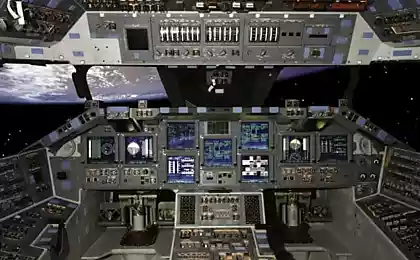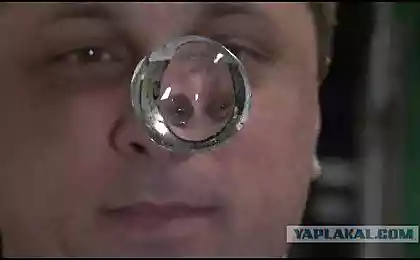639
Why in space experience a state nevesomos
Why do you think the astronauts in space experience a state of weightlessness? There is a high probability that the answer is not correct. The answer to this question you will find under the cut.

Asked why subjects and astronauts in a space ship appear in a state of weightlessness, many people give this answer:
1. In space there is no gravity, so they do not weigh anything.
2. Space - it is a vacuum, and the vacuum is no gravity.
3. The astronauts are too far from the Earth's surface that they could have a force of its gravity.
All of these answers are wrong!
The main thing to understand is that in space there is a force of gravity. This is a fairly common misconception. What keeps the moon on its orbit around the Earth? Gravity. What keeps the Earth in orbit around the Sun? Gravity. What prevents galaxies scatter in different directions? Gravity.
Gravity exists everywhere in space!
If you have built the world tower height of 370 km (230 miles), approximately the height of the orbit of the space station, the force of gravity acting on the top of the tower you would be almost the same as on the ground. If you decide to make a move from the tower, you would have rushed to the Earth in the same way as it is going to make later this year, Felix Baumgartner (Felix Baumgartner), when the attempt to make the leap from the edge of space. (Of course, if we do not take into account the low temperatures that are instantly start you freeze, or absence of air or air resistance will kill you, and a fall through the layers of air will make every part of your body to experience first hand what a "tear off three skins . "And besides, sudden stop and cause you a lot of inconvenience).
Yeah, so why space satellites or space station in orbit, falls to the ground, and why astronauts and surrounding objects inside the International Space Station (ISS), or any other spacecraft seem to float?
It turns out all about speed!
Astronauts itself the International Space Station (ISS) and other objects in Earth orbit, do not swim - in fact, they fall. But they do not fall to Earth because of the huge orbital velocity. Instead, they are "falling around" the Earth. The objects in Earth orbit should move at a speed of at least 28 160 km / h (17 to 500 miles per hour). Therefore, as soon as they are accelerated relative to the Earth, the force of Earth's gravity bends right and takes the path of downward movement, and they will never overcome this at least closer to the Earth. Because astronauts have the same acceleration as the space station, they experience a feeling of weightlessness.
It happens that we too can experience this condition - briefly - on Earth at the time of the fall. Have you visited the attraction "roller coaster" when immediately after passing the highest point ("top of the hill"), when the truck is already beginning to roll down your body raises c seat? If you were in the elevator at the height of the skyscraper stoetazhnogo and the cable is broken, the elevator is falling, you have floated in weightlessness in the car. Of course, in this case, the final would have been much more dramatic.
And then, you've probably heard about the airplane, providing a state of weightlessness («Vomit Comet») - the airplane KC 135, which NASA uses to create short-term state of weightlessness, to train astronauts and test experiments or equipment in conditions of weightlessness (zero-G) as well as for commercial flights in weightlessness as the plane flies in a parabolic trajectory as in the attraction "roller coaster" (but with high speeds and at high altitudes), it passes through the vertex of the parabola and rushes down, at the time of the crash, the conditions weightlessness. Fortunately, the plane out of a dive and leveled.
But let's get back to our tower. If instead of ordinary steps from the tower you made a running jump, your energy is directed forward, you would be carried away from the tower at the same time, the force of gravity would carry you down. Instead of landing at the base of the tower, you have landed at a distance from it. If you have increased during the run-up speed, you would be able to jump farther away from the tower before reached to the ground. Well, if you could run as fast as moving in an orbit around the Earth the space shuttle and the ISS at a speed of 28 160 km / h (17 to 500 miles per hour), the arc trajectory of your jump would make a circle around the Earth. You would be in orbit and was in a state of weightlessness. But you would be falling without reaching the Earth's surface. However, the suit and the air supply, suitable for breathing, you still need to. And if you could run at speeds of about 40 555 km / h (25 to 200 miles per hour), you would have jumped right out of the ground and began to revolve around the sun.
International orbiting space station, space shuttle ("Shuttle"), as well as satellites specially designed to remain in orbit, without falling to the ground and jumping up into space. They make a full circle around the Earth roughly every 90 minutes.
So when you're in orbit, you are in free fall and experience weightlessness.
NOW YOU KNOW EVERYTHING !!!
Thank you for the attention.
Source:

Asked why subjects and astronauts in a space ship appear in a state of weightlessness, many people give this answer:
1. In space there is no gravity, so they do not weigh anything.
2. Space - it is a vacuum, and the vacuum is no gravity.
3. The astronauts are too far from the Earth's surface that they could have a force of its gravity.
All of these answers are wrong!
The main thing to understand is that in space there is a force of gravity. This is a fairly common misconception. What keeps the moon on its orbit around the Earth? Gravity. What keeps the Earth in orbit around the Sun? Gravity. What prevents galaxies scatter in different directions? Gravity.
Gravity exists everywhere in space!
If you have built the world tower height of 370 km (230 miles), approximately the height of the orbit of the space station, the force of gravity acting on the top of the tower you would be almost the same as on the ground. If you decide to make a move from the tower, you would have rushed to the Earth in the same way as it is going to make later this year, Felix Baumgartner (Felix Baumgartner), when the attempt to make the leap from the edge of space. (Of course, if we do not take into account the low temperatures that are instantly start you freeze, or absence of air or air resistance will kill you, and a fall through the layers of air will make every part of your body to experience first hand what a "tear off three skins . "And besides, sudden stop and cause you a lot of inconvenience).
Yeah, so why space satellites or space station in orbit, falls to the ground, and why astronauts and surrounding objects inside the International Space Station (ISS), or any other spacecraft seem to float?
It turns out all about speed!
Astronauts itself the International Space Station (ISS) and other objects in Earth orbit, do not swim - in fact, they fall. But they do not fall to Earth because of the huge orbital velocity. Instead, they are "falling around" the Earth. The objects in Earth orbit should move at a speed of at least 28 160 km / h (17 to 500 miles per hour). Therefore, as soon as they are accelerated relative to the Earth, the force of Earth's gravity bends right and takes the path of downward movement, and they will never overcome this at least closer to the Earth. Because astronauts have the same acceleration as the space station, they experience a feeling of weightlessness.
It happens that we too can experience this condition - briefly - on Earth at the time of the fall. Have you visited the attraction "roller coaster" when immediately after passing the highest point ("top of the hill"), when the truck is already beginning to roll down your body raises c seat? If you were in the elevator at the height of the skyscraper stoetazhnogo and the cable is broken, the elevator is falling, you have floated in weightlessness in the car. Of course, in this case, the final would have been much more dramatic.
And then, you've probably heard about the airplane, providing a state of weightlessness («Vomit Comet») - the airplane KC 135, which NASA uses to create short-term state of weightlessness, to train astronauts and test experiments or equipment in conditions of weightlessness (zero-G) as well as for commercial flights in weightlessness as the plane flies in a parabolic trajectory as in the attraction "roller coaster" (but with high speeds and at high altitudes), it passes through the vertex of the parabola and rushes down, at the time of the crash, the conditions weightlessness. Fortunately, the plane out of a dive and leveled.
But let's get back to our tower. If instead of ordinary steps from the tower you made a running jump, your energy is directed forward, you would be carried away from the tower at the same time, the force of gravity would carry you down. Instead of landing at the base of the tower, you have landed at a distance from it. If you have increased during the run-up speed, you would be able to jump farther away from the tower before reached to the ground. Well, if you could run as fast as moving in an orbit around the Earth the space shuttle and the ISS at a speed of 28 160 km / h (17 to 500 miles per hour), the arc trajectory of your jump would make a circle around the Earth. You would be in orbit and was in a state of weightlessness. But you would be falling without reaching the Earth's surface. However, the suit and the air supply, suitable for breathing, you still need to. And if you could run at speeds of about 40 555 km / h (25 to 200 miles per hour), you would have jumped right out of the ground and began to revolve around the sun.
International orbiting space station, space shuttle ("Shuttle"), as well as satellites specially designed to remain in orbit, without falling to the ground and jumping up into space. They make a full circle around the Earth roughly every 90 minutes.
So when you're in orbit, you are in free fall and experience weightlessness.
NOW YOU KNOW EVERYTHING !!!
Thank you for the attention.
Source:























